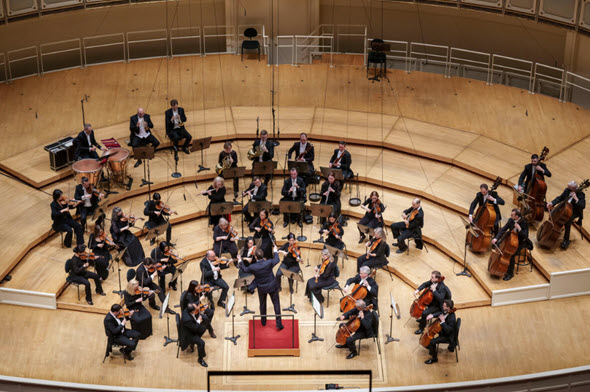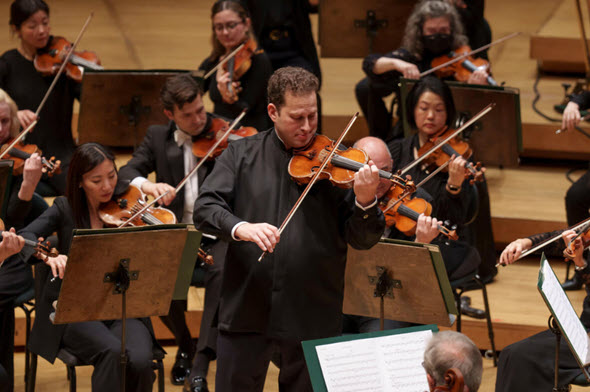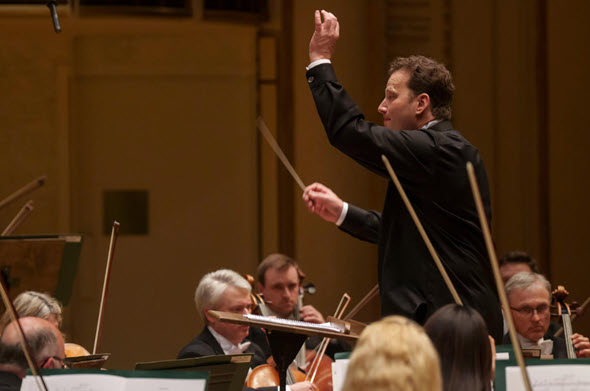When Chicago Symphony went small, intimate with Mozart and Stravinsky, impact went deep

It was a small version of the Chicago Symphony arrayed before conductor Nikolaj Szeps-Znaider. (Todd Rosenberg photos)
Commentary: Conductor-violinist Nikolaj Szeps-Znaider led down-sized CSO in music that drew musicians and audience together.
By Lawrence B. Johnson
In its small-scale fashion, last weekend’s Chicago Symphony Orchestra program with conductor-violinist Nikolaj Szeps-Znaider was the sleeper delight of the season thus far. To say it was a half-orchestra affair might be generous. Compared with the forces arrayed on stage at Orchestra Hall for Rimsky-Korsakov’s “Scheherazade” the week before, the diminutive band assembled around Szeps-Znaider barely filled the dimensions of a chamber orchestra. But what a sound that handful of musicians made, and what a display of style, polish and wit.
With Stravinsky’s spunky ballet “Pulcinella” in the middle, Szeps-Znaider’s program began and ended with Mozart – Violin Concerto No. 2 in D, which the conductor performed while standing amidst his fellow musicians, and Symphony No. 38 in D (“Prague”).
Just as that blazing “Scheherazade” had offered a showcase for the Chicago Symphony compleat, Mozart’s elegant and genteel Second Violin Concerto threw a dazzling light on a handful of the CSO strings. Mozart composed all five of his violin concertos in a single year, when he was 19, and each is a marvel in its own way. While the Third, Fourth and Fifth seem to turn up with about equal regularity, I’m not sure I’ve encountered the Second Violin Concerto twice in concerts in my life as a critic, and that goes back more than half a century. This was a genuine rarity, and a treat.
Szeps-Znaider did more than deliver a solo performance of unfailing finesse, warmth and poise; he elicited from his small band of supporters a luminous sound marked by both depth and restraint. This was the concerto concept still echoing the buoyancy, sheen and esprit of Baroque music. It was also chamber music, Hausmusik, with an aura of good friends convening, virtuosos all, one of them primus inter pares. What a lovely and enfolding way to begin a concert.
It was quite a different Mozart represented at the far end with the “Prague” Symphony. How fitting and rewarding to find this great symphony placed as capstone to an altogether brilliant evening. Mozart composed the work in 1786, between “The Marriage of Figaro” and “Don Giovanni,” and conducted the premiere in Prague. It was apparently the last of his symphonies that he heard. The famous final triptych of Nos. 39, 40 and 41, composed with incredible speed in the summer of 1788, remained in a drawer until after his death in 1791 at age 35.
The “Prague,” the only one of Mozart’s mature symphonies cast in three movements rather than four (it lacks a minuet), stands easily in the company of the later works, as Szeps-Znaider’s vigorous and clear-sighted account bore witness. It was also a brisk account. No layering on of Victorian pomposity here. This was agile, urgent, gleaming Mozart, keenly delivered front to back by a sparkling assembly of winds and strings, each one exposed in the glaring light of their modest numbers. Yet even on this small scale, the CSO musicians conjured in Mozart’s heroic finale a sense of majesty and sheer puissance.
I cannot hear Stravinsky’s droll, bright and biting music of “Pulcinella” without picturing the octogenarian composer on the podium at Orchestra Hall in 1965, leading the Chicago Symphony not just in the suite but in the complete ballet with soprano, tenor and baritone soloists. Stravinsky was infirm then and had to be assisted to the podium. But his beat was firm and his musical wit undimmed – not so different from the deliciously brash turn led by Szeps-Znaider in the ballet’s still-popular suite.
Although he has made regular appearances with the CSO in recent seasons, the intimacy of this program showed Szeps-Znaider to exceptionally good advantage. The stage was the same size, and the hall, but the conductor (and violinist) capitalized on the scale of the occasion to draw his audience in. The two Mozart works and “Pulcinella” alike evinced a palpable connection between musicians and audience. A listener departed into the night feeling refreshed, exhilarated in a world well in need of such feeling, such music.




